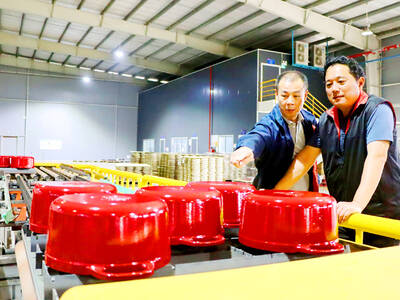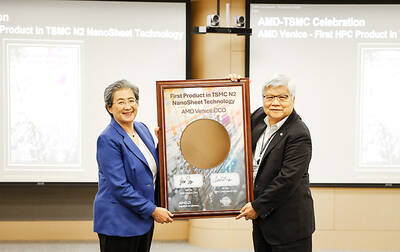The Chinese BeiDou (北斗) Navigation Satellite System would be complete this month when its final satellite goes into orbit, giving China greater independence from US-owned GPS and heating up competition in a sector long dominated by the US.
The idea to develop BeiDou took shape in the 1990s as the military sought to reduce reliance on the GPS run by the US Air Force.
When the first BeiDou satellites were launched in 2000, coverage was limited to China. As use of mobile devices expanded, China in 2003 tried to join the Galileo satellite navigation project proposed by the EU, but later pulled out to focus on BeiDou.
In the age of the iPhone, the second generation of BeiDou satellites went operational in 2012, covering the Asia-Pacific.
China began deploying the third generation of satellites aimed at global coverage in 2015.
The 35th and final BeiDou-3 satellite is to be launched this month — the day has yet to be announced — meaning BeiDou has more satellites in its system than GPS’ 31, and more than Galileo and Russia’s Glonass.
With estimated investment of US$10 billion, BeiDou would keep the communications network of the Chinese military secure, avoiding the risk of disruption to GPS in the extreme event of conflict.
Weapons targeting and guidance would also improve.
When complete, BeiDou’s location services would be accurate down to 10cm in the Asia-Pacific, compared with GPS’ 30cm range.
“BeiDou was obviously designed a few decades after GPS, so it has had the benefit of learning from the GPS experience,” Australian Centre for Space Engineering Research Director Andrew Dempster said. “It has some signals that have higher bandwidth, giving better accuracy. It has fewer orbit planes for the satellites, making constellation maintenance easier.”
BeiDou-related services such as port traffic monitoring and disaster mitigation have been exported to about 120 countries, state media reported.
Many of those countries are involved in the Belt and Road Initiative, spearheaded by Chinese President Xi Jinping (習近平) to create a modern-day Silk Road of trade and investment.
In a report last year, the US congressional US-China Economic and Security Review Commission warned that China promoted launch services, satellites and BeiDou under its “Space Silk Road” to deepen reliance on China for space-based services, potentially at the expense of US influence.
In 2013, Thailand and Pakistan were the first foreign countries to sign up for BeiDou’s services.
Within China, more than 70 percent of mobile phones were BeiDou-enabled as of last year, state media reported.
China’s satellite navigation sector might top 400 billion yuan (US$56.47 billion) in value this year, state media said.
Ahead of BeiDou-3’s completion, satellite-related shares have soared. Beijing BDStar Navigation Co (北京北斗星通導航), which makes chips that receive BeiDou signals, has surged 34.4 percent this year.

UNCERTAINTY: Innolux activated a stringent supply chain management mechanism, as it did during the COVID-19 pandemic, to ensure optimal inventory levels for customers Flat-panel display makers AUO Corp (友達) and Innolux Corp (群創) yesterday said that about 12 to 20 percent of their display business is at risk of potential US tariffs and that they would relocate production or shipment destinations to mitigate the levies’ effects. US tariffs would have a direct impact of US$200 million on AUO’s revenue, company chairman Paul Peng (彭雙浪) told reporters on the sidelines of the Touch Taiwan trade show in Taipei yesterday. That would make up about 12 percent of the company’s overall revenue. To cope with the tariff uncertainty, AUO plans to allocate its production to manufacturing facilities in

Taiwan will prioritize the development of silicon photonics by taking advantage of its strength in the semiconductor industry to build another shield to protect the local economy, National Development Council (NDC) Minister Paul Liu (劉鏡清) said yesterday. Speaking at a meeting of the legislature’s Economics Committee, Liu said Taiwan already has the artificial intelligence (AI) industry as a shield, after the semiconductor industry, to safeguard the country, and is looking at new unique fields to build more economic shields. While Taiwan will further strengthen its existing shields, over the longer term, the country is determined to focus on such potential segments as

TAKING STOCK: A Taiwanese cookware firm in Vietnam urged customers to assess inventory or place orders early so shipments can reach the US while tariffs are paused Taiwanese businesses in Vietnam are exploring alternatives after the White House imposed a 46 percent import duty on Vietnamese goods, following US President Donald Trump’s announcement of “reciprocal” tariffs on the US’ trading partners. Lo Shih-liang (羅世良), chairman of Brico Industry Co (裕茂工業), a Taiwanese company that manufactures cast iron cookware and stove components in Vietnam, said that more than 40 percent of his business was tied to the US market, describing the constant US policy shifts as an emotional roller coaster. “I work during the day and stay up all night watching the news. I’ve been following US news until 3am

COLLABORATION: Given Taiwan’s key position in global supply chains, the US firm is discussing strategies with local partners and clients to deal with global uncertainties Advanced Micro Devices Inc (AMD) yesterday said it is meeting with local ecosystem partners, including Taiwan Semiconductor Manufacturing Co (TSMC, 台積電), to discuss strategies, including long-term manufacturing, to navigate uncertainties such as US tariffs, as Taiwan occupies an important position in global supply chains. AMD chief executive officer Lisa Su (蘇姿丰) told reporters that Taiwan is an important part of the chip designer’s ecosystem and she is discussing with partners and customers in Taiwan to forge strong collaborations on different areas during this critical period. AMD has just become the first artificial-intelligence (AI) server chip customer of TSMC to utilize its advanced